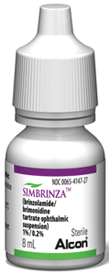 A 61-year-old male presented for a glaucoma consultation at the request of his local optometrist. The man had primary open-angle glaucoma for many years, and the resultant damage was more advanced in his right eye than his left eye. While his visual acuity measured 20/20 in each eye, his right visual field was damaged extensively (10° central field).
A 61-year-old male presented for a glaucoma consultation at the request of his local optometrist. The man had primary open-angle glaucoma for many years, and the resultant damage was more advanced in his right eye than his left eye. While his visual acuity measured 20/20 in each eye, his right visual field was damaged extensively (10° central field).
His untreated intraocular pressure (IOP) was 28mm Hg OD and 26mm Hg OS. It was believed that his target IOP should be less than 18mm Hg OU. Previously, he had achieved this target successfully with a prostaglandin analog (PGA); however, during the course of his care, he developed anterior uveitis twice in his right eye.
The uveitis was successfully treated each time, but there was concern that the use of a PGA may have contributed to the associated inflammation. The patient’s referring optometrist decided that PGAs should be avoided entirely due to his history of recurrent uveitis, and wanted an opinion regarding the next course of therapy.
When faced with a glaucoma patient who cannot use a PGA, we have to consider alternate therapies that offer a similar ability to reduce IOP. Glaucoma monotherapy often does not equate to the IOP reduction demonstrated by PGAs. Therefore, combination medications typically are the best option for such patients.

Until now, however, all available combination medications in the US have employed a beta blocker as one of their components––making these agents unsuitable for some patients. But, the recent FDA approval of Simbrinza (brinzolamide 1.0% and brimonidine 0.2%, Alcon) fundamentally changes the game.
A Word on Combination Glaucoma Meds
Fixed-combination medications that lower IOP often are used to treat glaucoma and ocular hypertension because they offer several potential advantages over the combined use of separate medications. These include: enhanced convenience, improved adherence, reduced exposure to preservatives and potential cost savings. Additionally, fixed combination agents reduce IOP more effectively than their component medications when used separately as monotherapy.1
Even with the advent of PGAs, many patients need two or more medications to achieve the desired therapeutic effect. In the Ocular Hypertension Treatment Study, nearly 40% of patients required two or more medications to achieve a target pressure reduction of 20% over five years.2 As more patients require multiple medications, the use of combination medications has become more commonplace.
Simbrinza
Simbrinza received FDA approval in April 2013. It is a topical ophthalmic suspension that combines a carbonic anhydrase inhibitor (brinzolamide 1%) with an alpha-2 adrenergic agonist (brimonidine 0.2%). It is approved and marketed for the reduction of IOP in patients with open-angle glaucoma and ocular hypertension. As a suspension, patients must shake the bottle prior to its use to ensure proper mixing.
The recommended dosing is three times per day, and the bottle size is 8ml to accommodate. Also, Simbrinza is unique in that it is the only fixed-combination glaucoma agent currently available in the US that does not feature a beta blocker.
Because Simbrinza combines two agents, it is important to be aware of potential complications and adverse reactions associated with the use of its components. Brimonidine has been noted to induce a small decrease in blood pressure after dosing. Thus, Simbrinza should be used with caution in patients who have severe cardiovascular disease.
Also, because brinzolamide is a carbonic anhydrase inhibitor, you must exercise discretion in patients who have sulfonamide hypersensitivity. Finally, there is a possibility of inducing corneal edema in patients with low endothelial cell counts (although this complication is not likely to occur in patients with normal corneas).3
Efficacy

Patients with primary open-angle glaucoma who have failed prostaglandin therapy may benefit from Simbrinza use.
In two identical clinical studies, researchers determined that Simbrinza yielded a substantial reduction in IOP.4,5 Both studies enrolled more than 650 patients with open-angle glaucoma or ocular hypertension.
After eligibility determination, patients underwent a washout of their existing therapies and were randomized to receive TID dosing of brinzolamide 1.0%, brimonidine 0.2% or Simbrinza.
The primary goal was to determine the IOP lowering effect the medications at all study points over a three-month duration. It is important to note that the patient treatment groups were stratified to create a nearly identical untreated baseline IOP, so that no group was favored over another.
The results of both clinical studies indicated that Simbrinza had a greater IOP lowering effect than either of its two components dosed separately. Simbrinza reduced mean IOP by 1.0mm Hg to 3.2mm Hg more than brinzolamide 1.0% and 1.7mm Hg to 2.8mm Hg more than brimonidine 0.2%.
In terms of a reduction from baseline, Simbrinza lowered mean IOP between 5.4mm Hg and 8.8mm Hg (21% to 35% respectively).4,5
Safety
In clinical trials, Simbrinza exhibited comparable side effects to those already known to be associated with the use of either brinzolamide 1.0% or brimonidine 0.2%––including blurred vision, hyperemia, dry eye, mild ocular irritation and dry mouth.3-5 The incidence rates of these effects were low and very similar to what has been seen in patients who separately use Simbrinza’s component medications.
Also, when evaluating its cardiovascular safety profile, researchers noted that there was a very small decrease in resting pulse rate and a clinically insignificant decrease in mean systolic and diastolic blood pressure––again, very similar to what has been seen in those using brimonidine 0.2%.3-5
Simbrinza’s Role in Glaucoma Therapy
Simbrinza has been approved as an initial, first-line therapy. This is very important for patients who cannot use a PGA. Not only can Simbrinza be used as first-line therapy, but also it can serve as a complete replacement for patients who failed PGA use. While studies of adjunctive use have not yet been published, it can be speculated that Simbrinza also would be effective and beneficial when added to a PGA regimen.
We educated our patient and his optometrist about the newly approved combination therapy, and all agreed that Simbrinza would be the most appropriate therapeutic option. The patient used the medication on a trial basis and tolerated it well, with no adverse effects. Subsequently, his IOP dropped to 16mm Hg OD and 17mm Hg OS––an excellent therapeutic outcome.
Drs. Sowka and Kabat are consultants for Alcon, but have no direct financial interest in any products mentioned.
1. Higginbotham EJ. Considerations in glaucoma therapy: fixed combinations versus their component medications. Clin Ophthalmol. 2010 Feb 2;4:1-9.
2. Kass MA, Heurer DK, Higginbotham EJ, et al. The Ocular Hypertension Treatment Study. A randomized trial determines that topical ocular hypotensive medication delays or prevents the onset of primary open angle glaucoma. Arch Ophthalmol. 2002 Jun;120(6):701-13.
3. Simbrinza package insert. Alcon Laboratories. Fort Worth, Texas.
4. Nguyen QH, McMenemy MG, Realini T, et al. Phase 3 randomized 3-month trial with an ongoing 3-month safety extension of fixed-combination brinzolamide 1%/brimonidine 0.2%. J Ocul Pharmacol Ther. 2013 Apr;29(3):290-7.
5. Katz G, Dubiner H, Samples J, et al. Three-month randomized trial of fixed-combination brinzolamide, 1%, and brimonidine, 0.2%. JAMA Ophthalmol. 2013 Jun 1;131(6):724-30.

